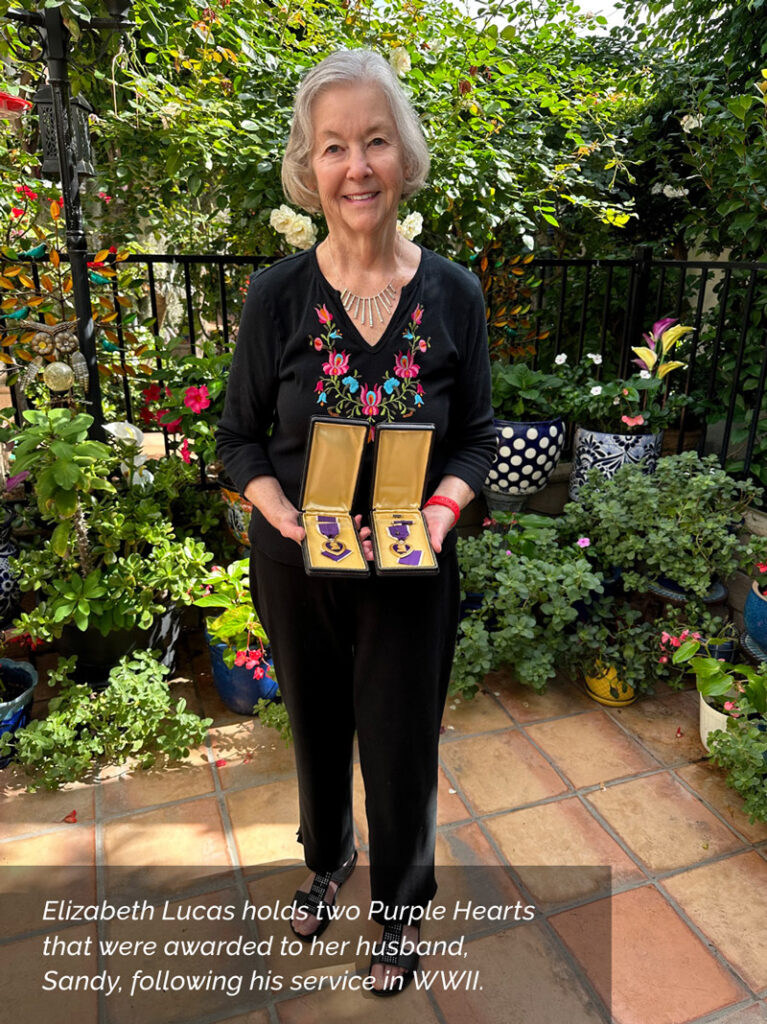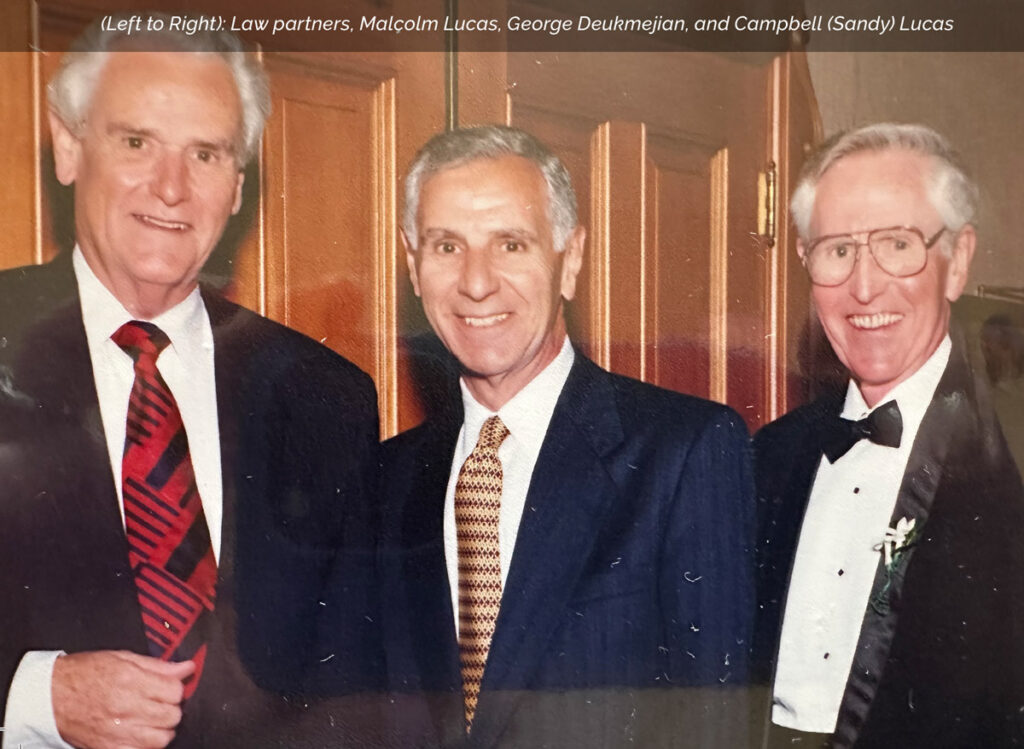
Your donation TODAY will help us receive a Matching Grant of $30,000 from the Larry and Helen Hoag Foundation. Please read on how Sandy Lucas, WWII POW and two-time Purple Heart recipient, motivated his wife, Elizabeth Lucas, to get involved.
Dear Friend of Fisher House So Cal,
That was the headline on Tuesday, May 8, 1945, in the Long Beach Press Telegram, after my future husband Campbell Lucas, nicknamed “Sandy”, whom I would marry in 1960, was rescued from a Nazi prison camp in Germany. The day after Sandy graduated from high school, he volunteered for the Army and was assigned to the 99th Infantry, where he fought in the Battle of the Bulge.
Sandy was a machine gunner who stayed behind on the battlefield to provide cover to his unit, but was captured by the Germans after his ammunition ran out. He was then sent to a Prisoner of War (POW) camp. During a long and arduous imprisonment, Sandy managed to escape, but was recaptured. As the headline indicates, he was finally liberated by advancing American troops.
When Sandy joined the Army, he was six feet tall and weighed about 140 pounds. When liberated, he weighed only 98 pounds.
He was awarded two Purple Hearts for injuries sustained on the battlefield and in the POW camp.
When Sandy came back from the war, with the help of the GI bill, he graduated from UCLA and USC, where he obtained his law degree in 1952. He then went on to a successful 50-year law career. His law firm partners included future California Governor George Deukmejian, and Sandy’s brother Malcolm Lucas, who would become Chief Justice of the California Supreme Court.
Sandy went on to become a judge (Los Angeles Superior Court, and Justice of the California State Court of Appeal), an arbitrator, and a mediator. He handled some of Hollywood’s most complex and contentious cases involving Hollywood figures like Aaron Spelling, Michael Ovitz, Elizabeth Taylor, Brad Pitt, The Beach Boys, and the Walt Disney Company.
Now, you might be asking, what does Sandy Lucas’ life have to do with Fisher House Southern California?
Well, I am proud to say it was Sandy’s life, especially his service to his country during World War II, that inspired me to get involved with Fisher House. It was my tribute to him, and to those service members who valiantly risked their lives to free him and his fellow POWs.
In 2013, a team of us founded Fisher House Southern California (FHSC) to assist the families of our veterans and military service members by giving them a ‘home away from home’ while their courageous loved ones – service members from wars in Vietnam, Korea, Iraq, and Afghanistan – receive medical care at a Veterans Administration (VA) or Navy hospital.
Since 2013 we have raised the money to build the Fisher House at the VA – Long Beach (a $6 million project), and continue to maintain the three other Fisher Houses, one at the Naval Hospital on Marine Corps Base Camp Pendleton and two at the Naval Medical Center in San Diego.
Even more important, in the past ten years, our Fisher Houses have served nearly 7,000 families, saving them more than $10 million.
You see, care at the Fisher House is always free, as we provide our families with beautiful accommodations, including spacious living rooms, dining rooms, kitchens, libraries, playrooms and bedroom suites for the families, especially families with children. We also provide food, clothing, transportation, and whatever else our families need during their stay.
And that’s why I am writing you today – to ask you to help the families who stay at our Fisher Houses.
Your gift – made by December 31 – will be matched dollar-for-dollar by the Larry and Helen Hoag Foundation, up to $30,000, especially for the children of the families we serve.
Won’t you help support our veterans and military families in their time of critical need? With Veterans Day and the Holidays around the corner, please join us in helping to make our holiday seasons joyous ones for those families whose loved ones require treatment in one of our VA or military hospitals in Southern California.
On their behalf, and on behalf of all the men and women who, like my husband Sandy, have served our country in its time of need, thank you so much for your kindness and your generosity.
Thank you for making your gift on-line today, or by mailing a gift to Fisher House So Cal before December 31 to: PO Box 110, Long Beach, CA 90801 so that we can be sure to double your donation with the Larry and Helen Hoag Foundation matching funds, and continue to provide our veteran and military families with a safe and comfortable place to stay – at no cost to them – for as long as needed – during times of medical need.
We’re truly grateful for your support!
Yours truly,
Elizabeth “Liz” Lucas
Board Member and Secretary, Fisher House Southern California
The War-Time Years
As a young 17-year-old, Sandy enlisted in the U.S. Army in 1942, the day after graduating from Wilson High School in Long Beach, CA as the Class Salutatorian. The Army sent him to the University of Arkansas to be trained in Civil Engineering. The goal was that he would join the Army Corps of Engineers as an officer.
However, World War II was raging. When the Germans launched their last major offensive campaign, which later became known as the Battle of the Bulge, the Army reassigned all those training in engineering and made them infantrymen. Sandy was sent to Fort Benning, Georgia for basic training, and was then assigned to the 99th Infantry, where he ultimately fought at the Battle of the Bulge.
Sandy described being a machine gunner and how, while on patrol in Belgium, he and his fellow soldiers were caught in an open field by the Germans. Sandy and another soldier volunteered to stay behind and provide cover so the patrol could withdraw. Sandy manned the machine gun while his fellow soldier fed ammunition into the gun. His patrol was supposed to order an artillery barrage to provide Sandy and his fellow soldier with cover during their withdrawal, but the help never came. Sandy fired his weapon until he ran out of ammunition, and that’s when he was captured and taken prisoner by the Germans.
During the engagement, a German bullet went through Sandy’s helmet and grazed his eye. For his injuries, he was later awarded The Purple Heart medal.
Later in the war, as the Allied troops advanced, the Germans fell back in disarray. Sandy and his fellow prisoners were relocated several times and ultimately loaded into boxcars for transport to Germany. The air passages were sealed up, and it was hard to breathe in the dark crowded boxcars, where they would remain for nearly a week. Worse yet, planes from our ally, the Royal Air Force (RAF), did not realize that the boxcars held prisoners of war, so they proceeded to bomb the rail lines around the boxcars, which further terrorized the prisoners.
The situation got so intense that several men had nervous breakdowns. During a transfer between trains, Sandy and another soldier escaped, but being without food and suffering from the cold, they surrendered to a local village militia.
Sandy’s next Prisoner of War camp was bitterly cold. Blankets, often made from paper, provided little warmth. Meager food rations consisted of boiled potatoes, black bread, and occasional soup made of flour and water. These conditions resulted in frostbite and near-starvation, which were recognized by the award of a second Purple Heart medal.

As the Allied advance drew near, the Germans abandoned the prisoners in their camp, and American soldiers eventually found Sandy and his fellow captives. When Sandy was liberated by U.S. Armed Forces in January 1945, at six feet tall, he weighed just 98 pounds.
Winston Churchill would call the Battle of the Bulge “the greatest American battle of the war”, which proved to be the costliest ever fought by the U.S. Army, which suffered over 100,000 casualties over six brutal weeks, and which paved the way to victory for the allies.
The Post-War Years
With the focus on destroying the enemy and on personal survival, it’s hard to imagine a young soldier named Sandy Lucas envisioning that he would one day use the GI Bill to go to UCLA, then USC where he obtained his law degree in 1952.
Or that he would have a successful law career with partners Malcolm Lucas, his brother, who eventually became Chief Justice of the California Supreme Court, and George Deukmejian, who would become Governor of California.
As a malnourished soldier held captive by the Germans, even Sandy likely never imagined that one day he would be appointed to the Los Angeles Superior Court by Ronald Reagan, and a few years later, to the California State Court of Appeal by Governor George Deukmejian, and later become both Presiding Justice and Administrative Presiding Justice for the California State Court of Appeal.
Or that he would marry Elizabeth (Liz) Buse, the love of his life, in 1960, and they would have three beautiful children together.
Paying it Forward
Fisher House Southern California
Thanks to the military and the benefits afforded to him, Sandy was able to have a successful career in law so that he could provide for his family, and even have a second career as an arbitrator, mediator and referee. He specialized in some of Hollywood’s most complex and contentious cases, involving such Hollywood figures as Aaron Spelling, Michael Ovitz, Elizabeth Taylor, Brad Pitt, The Beach Boys, and the Walt Disney Company.
Sandy would spend years ‘giving back’ to his country and community during his lifetime, serving as President of the Navy League in Long Beach and many other organizations.

Married to Sandy for 44 years, Liz was inspired to get involved with Fisher House Southern California. She credits Sandy’s military life with helping him become the man he was. She recognized the extraordinary sacrifices our service men and women and their families make daily on behalf of our country to keep us free – sacrifices made by regular people like her husband, Sandy, and she was motivated to give back and help those veterans, service members and their families.
Sandy Lucas led a life well lived, and created a beautiful legacy that is alive and well today in Liz’s dedication to Fisher House, manifested through Sandy’s courage and service to his country, all those years ago.

“It was Sandy’s military life that helped him to become the man he was, and that motivated me, even in the later stages of my life, to do what I could for my country, just as Sandy did those many years ago.
Serving our veterans and activeduty service members through Fisher House So Cal is my tribute to him, and to all those who make sacrifices to help keep America free and out of harm’s way.”

